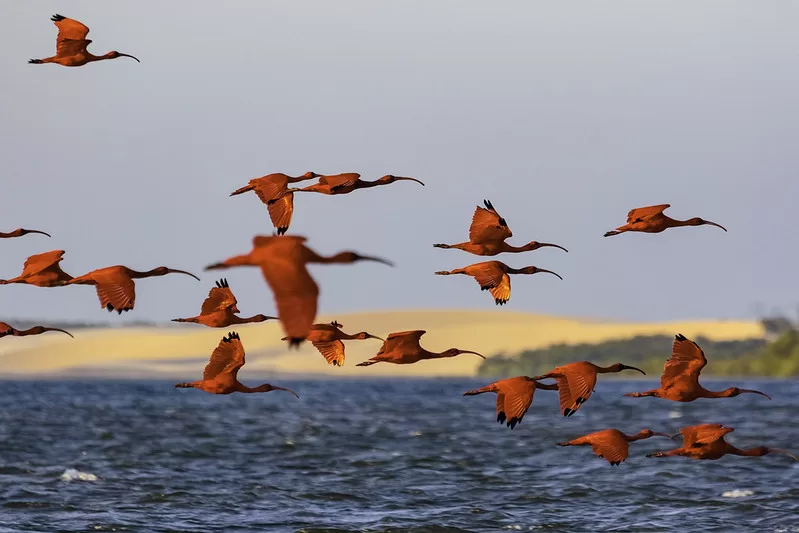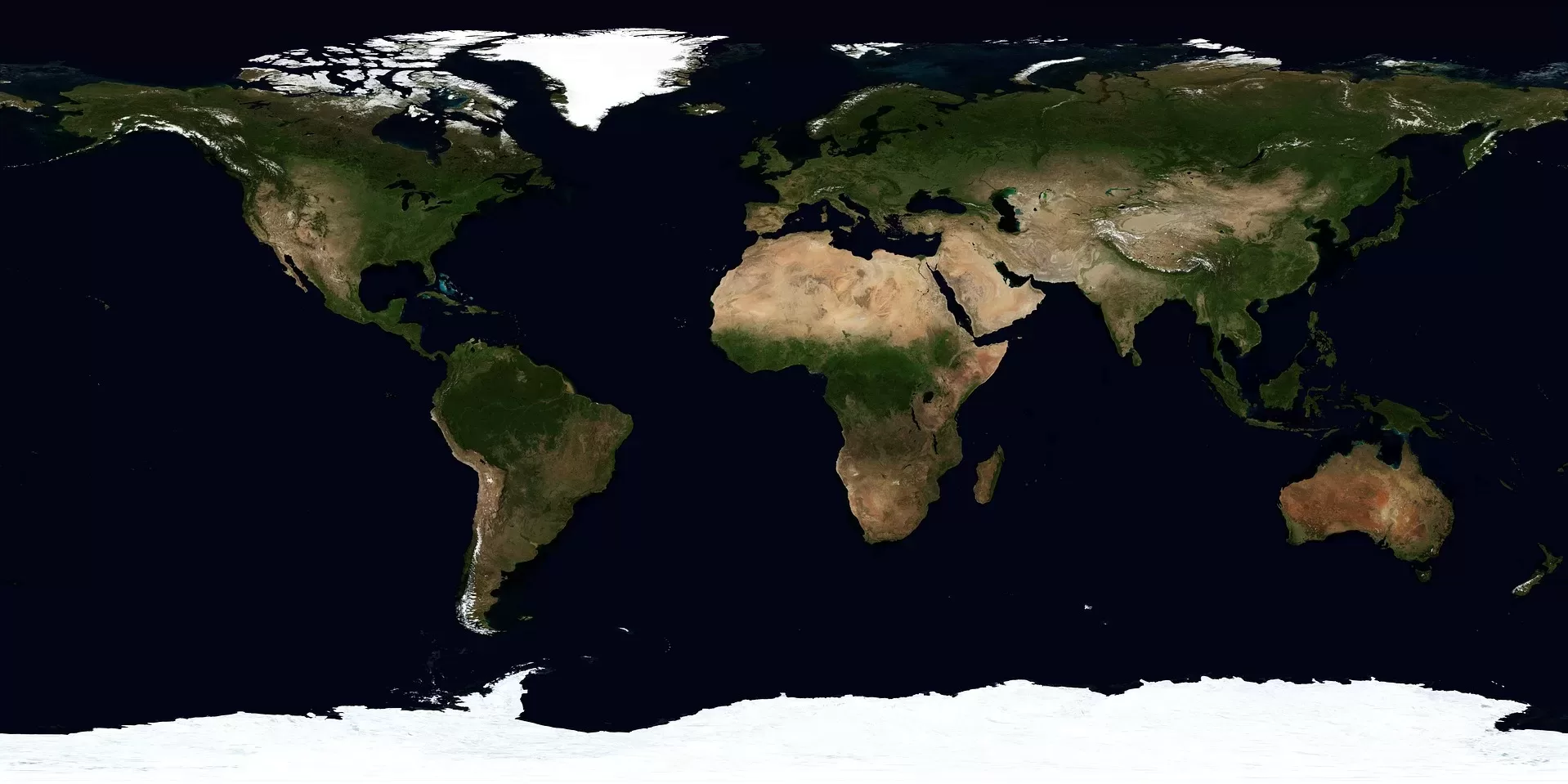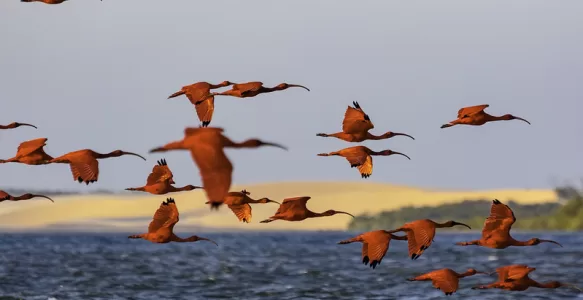The Parnaíba Delta is located in the northernmost part of Piauí, on the border with Maranhão. It is a rare and impressive hydrographic phenomenon—the only open-sea delta in the Americas and the third largest in the world, surpassed only by the Nile Delta in Africa and the Mekong Delta in Asia.

Before flowing into the Atlantic Ocean, the Parnaíba River branches into dozens of arms, forming an archipelago of more than 75 islands. With dunes, freshwater lagoons, mangroves, and igarapés, the delta showcases a natural mosaic that captivates travelers seeking exotic, untouched landscapes. It is a place of raw beauty, where time slows down and wildlife thrives in harmony with the environment.
Geographical Uniqueness
What makes the Parnaíba Delta so unique is its geological and hydrographic formation. While most of the world’s deltas are formed in bays or protected areas, the Parnaíba Delta forms directly into the open sea. This requires resilience from its natural formations, such as islands and sandbanks, which face constant Atlantic tides and winds.
The river branches create a natural labyrinth of navigable channels before reaching the ocean. These channels shape a stunning landscape of mangroves, floodplains, coastal forests, dunes, and tropical vegetation. The richness of this biome supports immense biodiversity, attracting biologists, environmentalists, and eco-conscious travelers from around the world.
Notable Islands and Destinations
The Parnaíba Delta hosts a variety of islands that serve as ecological sanctuaries. Some stand out for their beauty as well as the infrastructure available for tourism.
- Ilha das Canárias: One of the largest and most well-known islands, it belongs to Maranhão and is home to traditional communities. Visitors can stay in rustic guesthouses, cycle through trails, or take boat tours to observe wildlife such as scarlet ibises, monkeys, and caimans.
- Igaraçu: Located at the transition between the coast and the semi-arid interior, this is one of the delta’s main riverine entry points. It’s widely used for navigation and fishing and is surrounded by lush vegetation.
- Ilha do Caju: A true ecological sanctuary. Its fauna includes giant anteaters, deer, capybaras, and migratory birds. The vegetation combines Atlantic Forest, restinga, and mangrove ecosystems. Rustic lodging is available for those seeking immersion in nature.
- Ilha da Melancieira: Lesser-known but equally charming, featuring dune landscapes, lagoons, and native vegetation. Ideal for those looking for solitude and serenity.
- Tutoia: Although not part of the main islands, this town in Maranhão serves as a key base. It offers accommodations, restaurants, and excursions to both the delta and Lençóis Maranhenses, making it a great option for combining travel routes.
Preserved Landscapes and Ecotourism
The Parnaíba Delta acts as an ecological sanctuary protecting multiple sensitive biomes. Mangroves serve as nurseries for fish and crustaceans. Wind-shaped dunes create cinematic landscapes, and rainwater lagoons become havens for migratory birds.
The local fauna is extraordinarily diverse. The scarlet ibis, known for its vivid red plumage, is a major attraction. At dusk, entire flocks return to the mangroves to roost, creating a stunning visual against the sunset. Other regional inhabitants include caimans, otters, iguanas, river dolphins, anteaters, and even small wildcats.
Due to its ecological significance, the delta is designated as a preservation area. Ecotourism continues to grow, with local tour operators offering guided excursions that respect environmental guidelines and promote education.
Recommended Activities and Tours
A wide range of tours offers varying intensities and durations to explore the Parnaíba Delta. Most tours depart from Parnaíba (PI), Ilha Grande (PI), Tutoia (MA), or Paulino Neves (MA).
- Scarlet Ibis Sunset Tour: Perhaps the most iconic of all, this tour takes visitors through channels and igarapés to a prime observation point where hundreds of scarlet ibises return at sunset. Departures are usually around 3 PM and return after dusk. The sight is unforgettable.
- Dune and Lagoon Expeditions: In the area bordering Lençóis Maranhenses, the delta’s dunes stretch toward the coast. During the rainy season, freshwater lagoons form, creating landscapes similar to those of Lençóis. 4×4 tours depart from Paulino Neves, traversing this less-explored region of Maranhão.
- Mangrove Canoe Trails: Kayaks and canoes allow visitors to navigate narrow creeks flanked by dense vegetation. This intimate experience offers close contact with the mangrove ecosystem and a higher chance of spotting wildlife in its natural habitat.
- Visits to Traditional Communities: Several delta islands are inhabited by fishing communities, like those on Ilha das Canárias. Visiting these areas provides insight into local culture, traditional cuisine, and how people coexist sustainably with nature.
Best Time to Visit
The Parnaíba Delta has a tropical climate, with temperatures ranging from 18°C to 39°C. The rainy season runs from January to May. During this time, rivers swell, lagoons form more easily, and vegetation becomes lush.
The period from May to August is ideal for visiting, with milder temperatures, less rain, and optimal conditions for excursions. Between April and July, wildlife sightings are most frequent, as animals approach riverbanks to feed.
Even during the dry season, from September to December, the delta remains a worthwhile destination—especially for hiking, wildlife photography, or simply relaxing in nature.
Regional Cuisine
The local cuisine is rich in seafood, with the uçá crab being a standout dish. Prepared with saltwater or local spices, it is typically served in shells, accompanied by flour, rice, vinaigrette, or cassava crumbs.
Other popular dishes include yellowtail stew, shrimp in coconut milk, various moquecas, and appetizers like fish balls and breaded crab claws.
Parnaíba offers well-structured restaurants, while islands and fishing villages provide homemade meals prepared by locals using fresh, regional ingredients. Simplicity in preparation enhances the natural flavors.
How to Get There
The closest city with solid infrastructure is Parnaíba, in Piauí. The João Silva Filho Airport receives direct flights from Teresina, Fortaleza, and other northeastern capitals. From Teresina, it’s about 332 kilometers to Parnaíba via BR-343.
By car, the trip takes 5 to 6 hours. For those coming from Maranhão, the main entry point is Tutoia, accessible from Barreirinhas or São Luís by road and boat segments.
From Parnaíba, local tour agencies offer transfers to Ilha Grande, the main departure point for delta exploration by boat.
Travel Tips
- Wear light clothing and sunscreen: The region is hot and humid. Light-colored clothes, hats, and sunglasses are essential.
- Bring insect repellent: Mangrove areas have mosquitoes, especially in the late afternoon.
- Choose local operators: Local guides have deep knowledge of the area and help promote sustainable tourism.
- Avoid disposable plastics: The delta is a fragile ecosystem and requires mindful practices.
- Book lodging in advance: During school vacation months (January and July), demand can spike.
A Brazilian Natural Gem
The Parnaíba Delta is undoubtedly one of Brazil’s most remarkable destinations. It blends untouched nature, extraordinary biodiversity, traditional culture, and paradise-like landscapes. Still off the radar of mass tourism, the delta offers an authentic and transformative experience.
For travelers seeking more than crowded beaches, this territory between Maranhão and Piauí offers a chance to reconnect with nature and simplicity. Each tour reveals a new scene, each river bend hides a surprise, and each sunset confirms the grandeur of Brazil’s natural heritage.


